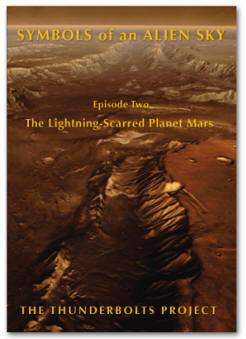A recent
press release announced
the "discovery" of a planet in orbit
around a pulsar that is thought to
have once been a star, but is now a
planetary body composed of something
similar to compressed carbon, or
diamond.
The reason for the supposed
density and composition assumptions
is that the "planet" was seen in an
orbit around the pulsar that is
deemed impossible to consensus
astrophysicists. As announced by the
Max Planck Institute for Radio
Astronomy in Bonn, Germany, pulsar
J1719-1438 rotates more than 10,000
times per minute, has a mass of
about 1.4 times that of our Sun, but
is only 20 kilometers in radius.
What is it about the planet's orbit
that causes the assumption it is
crystalline and extremely dense?
The first step in this chain of
circumstances is neutron star
theory. Pulsars are neutron stars is
the second link. As the theory
posits, a neutron star comes into
being when a star with at least five
times the mass of the Sun implodes,
shedding its outer layers in a
supernova. Since the star is no
longer able to shield itself from
its own immense gravity with
thermonuclear fusion theory,
gravitational acceleration theory
takes over, pulling all the
electrons in the remaining stellar
matter into the nuclei. Two more
links.
The massive star's original
angular momentum remains, so its
rotational period can be
astonishing, as J1719-1438 attests.
The increase in rotational velocity
can be likened to an ice skater's
arms stretched out in a slow spin
and then pulled in tight, thus
increasing the spin rate. Another
link. The forces generated when
trillions of gigatons spin as fast
as a dentist's drill means that the
star ought to burst apart like a
cracked flywheel. However, enough
mass is added to the theory so that
gravity can hold it together.
There is thought to be an intense
magnetic field surrounding a pulsar
that is focused at each pole. Narrow
beams of radio waves blast out from
the polar cusps like lighthouse
beacons, and whenever that beam
intersects Earth, telescopes fitted
with gamma ray, radio wave, or X-ray
detectors can see it. The final
theoretical link in the pulsar chain
of circumstances is the tidal force
theory that would tear apart a
companion star or planet if it came
too close.
Before discussing the nature of
the planet in orbit around the
pulsar, it should be pointed out
that there was no observation of the
pulsar. Rather, researchers first
"found" it in 200,000 Gigabytes of
data obtained from three different
radio telescopes, analyzed by
supercomputers at three different
computation centers, using
customized software.
Since J1719-1438's pulses in the
data were seen to be "systematically
modulated," the only conclusion
their computer models could reach is
that a companion planet is in orbit
around the pulsar. Astronomers think
an original stellar companion gave
up most of its material to the
pulsar. As theory supposes, this
results in a millisecond pulsar with
a white dwarf companion.
J1719-1438 and its dwarf partner
are thought to be close together, so
the companion "must be" a white
dwarf that has lost 99.9% of its
original substance, leaving behind
what astronomers suggest is a
planet-sized carbon and oxygen
sphere. Any lighter element
constituents would mean the star
(planet) "would be too big to fit
the measured orbiting times."
Another possibility, one not
considered by contemporary
astrophysicists, is that electrical
oscillations are causing the rapid
flicker of pulsars. Don Scott, in
his book “The
Electric Sky,” stresses that
neutron stars are impossible
phantoms, suggesting instead that
there is an electrical explanation
for their periodic pulses. He
proposes that pulsars are relaxation
oscillators; their pulse frequencies
are not mechanical. Instead, it is
the capacitive, resistive, and
inductive electrical environment
around the star. Compacted matter
and extreme rotation are not
necessary. Electricity traveling
through circuits provides a coherent
explanation that is consistent with
commonly accepted electromagnetic
theories, as well as with laboratory
experiments.
When the focus shifts from
gravity and gas toward the
electrical behavior of an entire
system, then steps can be taken that
will help to quantify the absolute
current density in that system, as
well as the capacitive and resistive
values, and the magnetic fields
generated by the inductive
interaction of the binary pair.
There must be an electric current
generating the intense magnetic
fields in a pulsar. It is also
indisputable that the feeder current
must be part of a circuit, since
persistent electric current must
complete a circuit. That circuit
includes the galaxy in which stars
reside, along with all the other
galaxies associated with their
clusters. Pulsar oscillations are
most likely complex in their
origins.
Stephen Smith
 New
DVD
New
DVD
The Lightning-Scarred
Planet Mars
A video documentary that could
change everything you thought you
knew about ancient times and
symbols. In this second episode of
Symbols of an Alien Sky, David
Talbott takes the viewer on an
odyssey across the surface of Mars.
Exploring feature after feature of
the planet, he finds that only
electric arcs could produce the
observed patterns. The high
resolution images reveal massive
channels and gouges, great mounds,
and crater chains, none finding an
explanation in traditional geology,
but all matching the scars from
electric discharge experiments in
the laboratory. (Approximately 85
minutes)
Video Selections
Order Link





 New
DVD
New
DVD

